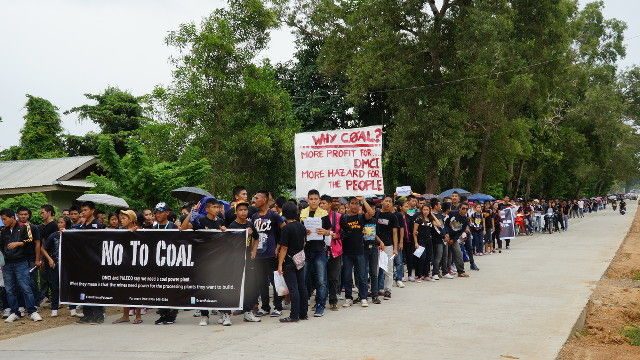SUMMARY
This is AI generated summarization, which may have errors. For context, always refer to the full article.

MANILA, Philippines – Will DMCI Power Corporation be allowed to put up a coal-fired power plant in Palawan?
After the Palawan provincial government approved the controversial power plant last May 28, the ball is now in the court of the Department of Environment and Natural Resources (DENR).
DMCI has already submitted an application for an Environmental Compliance Certificate (ECC) for a 15-megawatt coal-fired power plant in the province, DENR’s Environmental Management Bureau (EMB) Director Jonas Leones told Rappler on Wednesday, June 3.
The EMB is the agency that processes ECC applications. An ECC is a document that confirms a project abides by environmental regulations imposed by the national government.
But before an ECC can be issued, Leones said DMCI has to submit an Environmental Impact Statement (EIS) to EMB. Such a document lists how the coal power plant will affect the environment and the residents of Narra town, its proposed location.
The EIS will then be assessed by an “independent” review committee composed of 6 to 7 scientists. Such an assessment will take at least a month as experts will check how the project impacts water, biodiversity, air, and other aspects, said Leones.
As of June 3, DMCI has not yet submitted an EIS.
Only when the EIS passess the review committee will it be endorsed to Environment Secretary Ramon Paje for approval. It’s then up to Paje whether or not to issue an ECC.
But even the ECC is not the end of the line, said Leones. The local government of Narra can still oppose the project.
“The ECC lists down the possible impacts of the project and the corresponding mitigating measures. A copy of the ECC is sent to the LGU. But if the LGU still doesn’t want the project, they can stop it,” Leones told Rappler.
One of the restrictions listed in an ECC is that the project needs permits from the LGU, he added.
Questionable approval process
Former Puerto Princesa City mayor Edward Hagedorn appealed to the DENR not to issue an ECC for the coal power plant.
Along with green groups, he condemned the province’s approval of the project, saying it endangers the province’s residents and biodiversity.
During a May 28 meeting, the Palawan Council for Sustainable Development (PCSD) issued a Strategic Environmental Plan (SEP) clearance to DMCI. The SEP clearance is one of the requirements of the DENR before the issuance of an ECC.
The coal plant has been fiercely opposed by Palaweños since 2013 who say the power plant is likely to pollute its surroundings leading to loss of wildlife and health problems for communities.
“Political arrogance and self interest trumped the overwhelming voices of the people of Palawan who have vehemently opposed the plant in the last two years,” said Hagedorn in a statement sent to media on June 2.
Hagedorn, who was Puerto Princesa City mayor for two decades since 1992, said the PCSD’s decision overrode the requirement for genuine consultations among Palaweños who will be affected by the coal-fired power plant’s operations.
“There was no proper debate on this project in the PCSD. The so-called consultations in the communities were rigged. There wasn’t even a proper proposal submitted by DPC for technical studies,” he said.
Derailed project
The municipal council of Narra, back in 2013, issued a resolution opposing the DMCI power plant. Environmentalists worried the plant could harm populations of the critically-endangered Philippine cockatoo which forage in a marine protected area in the town.
This led DMCI to scout for another location, settling on Aborlan town.
But Aborlan residents didn’t want the coal power plant either.
In December 2013, a regional trial court temporarily stopped its construction after Aborlan residents insisted that DMCI and town officials failed to properly consult with them.
A local environmental group, the Palawan Alliance for Clean Energy (PACE), agreed the PCSD railroaded the usual permitting process that such projects should be subjected to.
“There was no informed participation in the environmental impact assessment process. This denied community residents unbiased access to information on the coal power plant project,” said PACE in a June 3 statement.
Power crisis
Both Hagedorn and PACE blamed the lack of transparency on the PCSD’s chairman, Palawan Governor Jose Alvarez.
“Governor Jose Alvarez held sway over all the other local officials including the mayors of Puerto Princesa City and the municipality of Narra who meekly kept their mouths shut when the resolution was made,” reads the PACE statement.
The coal-fired power plant was rationalized by the Department of Energy as a cheap way to solve Palawan’s power crisis.
The island-province, a popular tourism destination, is besieged by hours-long black-outs. Around 60% of villages have no power.
But the cheap power supply could come at the cost of the environment, health and livelihood of Palaweños, said Leon Dulce of the Kalikasan People’s Network for the Environment.
Air pollution and waste water from the coal combustion process could endanger fish sanctuaries, forests, agricultural lands, he explained.
Other green groups like Worldwide Fund for Nature Philippines say that renewable energy, not coal, is the answer to Palawan’s power problems.
Green groups say only renewable energy, which poses little or no environmental harm, can safeguard Palawan’s reputation as the country’s last ecological frontier. – Rappler.com
Add a comment
How does this make you feel?
There are no comments yet. Add your comment to start the conversation.